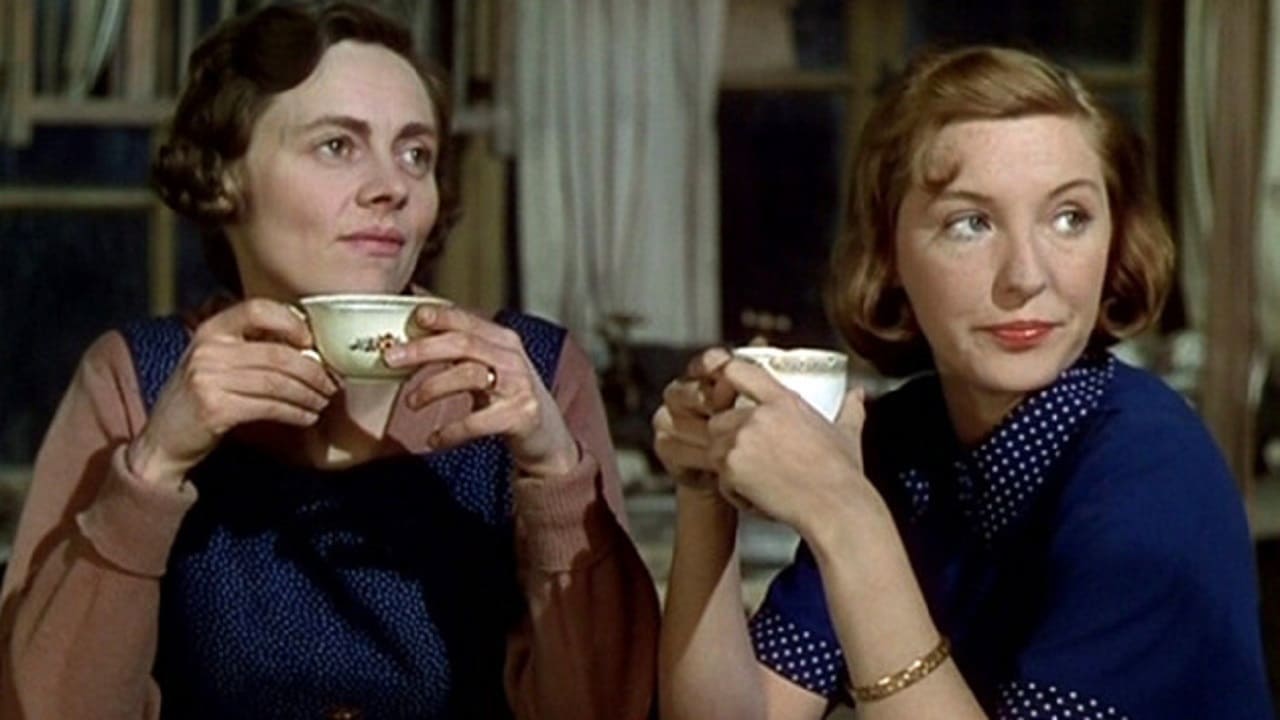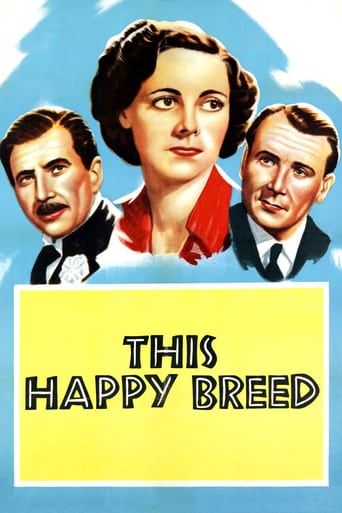Smartorhypo
Highly Overrated But Still Good
TrueHello
Fun premise, good actors, bad writing. This film seemed to have potential at the beginning but it quickly devolves into a trite action film. Ultimately it's very boring.
Fairaher
The film makes a home in your brain and the only cure is to see it again.
Freeman
This film is so real. It treats its characters with so much care and sensitivity.
lucyrfisher
As others have said, the story follows the Gibbons family in Clapham from 1919 to 1939. The central characters (the parents) are played stunningly by Robert Newton and Celia Johnson. Mr Gibbons is a bit like Polonius - always coming out with rather cliché'd advice. But his children hear his warmth and concern and support - which is what really matters. Mrs Gibbons is more acerbic and constantly trying to stop the others rowing.The old mother and widowed aunt are brilliant. Coward gets in some superb satire of both hypochondria and Christian Science (the aunt switches tack halfway through the story).I enjoyed the technicolour, because the clothes are PERFECT. For anyone interested in fashion history, this film has everything. The old mother, like Queen Mary, never updates her look from before WWI, favouring long skirts and "toques" (see Queen Mary's hats). The aunt is always slightly behind the times. Only Kay Walsh is slightly out of period - her Charleston dress has a waist! Tsk, tsk. And she can't quite bring herself to adopt the dated hairstyles that must have seemed frumpy to her. She's brilliant in her part, though, complaining that her family are "common".The left-wing views of the son, Reg, and his friend are sent up, but at the time it was the communists who fought the fascists, and the boys get beaten up in a clash with Mosleyites.Just one point - other reviewers from the States have called the family "middle class". This may be confusing for Brit readers - their classification is different! They are lower-middle-class: hard-working and aspirant. I've forgotten what Mr Gibbon's job is, but somehow it supports a house, three children, two relatives, a cat, and a maid. However, maids were cheap back then, and one woman couldn't have done the work of a house that size.We're told, however, that she gets help from her daughters (though not the parasitic relatives). The maid is a bit caricatured - maids were stock comic characters in 30s plays - but she is treated as one of the family and Mr G even helps her fold the tablecloth.The family don't exactly speak Cockney, just a bit "common". By the way, Noel Coward was not "patrician". Didn't he grow up in a family and house like this? He invented his aristocratic persona and accent. I don't think anybody really talked like thet!
kijii
This is the second of four David Lean-Noel Coward joint ventures. The other joint ventures are In Which We Serve (1941), Blithe Spirit (1945), and Brief Encounter(1945). This movie has a great British cast including actors that were featured in other of the Lean-Coward movies mentioned above: Celia Johnson, Stanley Holloway, Kay Walsh, and John Mills.This Happy Breed portrays a middle-class family living together in a small London flat. It takes place between the two world wars (1919- 1939). By using a limited cast over a long time span, we get to better know the 'personality' of the family and its next-door neighbors. As the story evolves, it highlights and follows the characters while relating the parallel story of England over that same period.As the movie opens, it is 1919 and the Great War has recently ended. Frank Gibbons (Robert Newton) and his wife, Ethel (Celia Johnson) are moving into their small London flat with their family of two daughters and one son. The core family is extended by Frank's widowed sister, Sylvia (Alison Leggatt), and Ethel's mother, Mrs. Flint (Amy Veness). These two women constantly argue and complain without contributing much to the family's well being. When the next door neighbor, Bob Mitchell (Stanley Holloway), introduces himself, he and Frank recall that they were in the war together and become great pals.Some years later, Bob's son, Billy (John Mills) falls in love with one of the Gibbons' daughters, Queenie (Kay Walsh—David Lean's wife at the time). But his love is not requited since Queenie wants something better out of life than the one she presently sees around her. (Though she loves Billy, future prospects with him don't look any different.) The Gibbons' son, Reg (John Blythe) goes through a politically rebellious period with his friend, Sam Leadbitter (Guy Verney), who later marries the other Gibbon's daughter, Vi (Eileen Erskine). Though all members of the family are well developed in the movie, that of Frank and Ethel are more fully realized as the judicious and loving father and the more harsh and punitive mother. Frank seems to have just the touch to guide his children through their rebelliousness; while Ethel often has to play traffic cop among the family members.On first viewing, there doesn't seem to be much going on in the movie. However, one soon realizes that this story is rich in wisdom and worthwhile seeing. I think that this is the type of movie that more aptly represents British, rather than American, sensibilities. In fact, while watching this movie, it reminded me of another one, Cavalcade (1933), based on another Noel Coward play. The latter, was nominated for 4 Academy Awards and won 2---Best Picture and Best Director (Frank Lloyd). Cavalcade covered an upper class English family marching through time—from the Boer War (1899) and death of Queen Victoria(1901) to c. 1932. While the two movies follow a similar formula with some overlap in there time lines, Cavalcade has a more 'Time Marches On 'attitude about it. It also uses both the family and its servants in sort of an "Upstairs, Downstairs" mode. On the other hand, This Happy Breed concentrates more on its characters. While it, too, tells the story of a family with concurrent English history—such as the death of Geroge V, a passing reference to abdication of Edward VIII, and the infamous Neville Chamberlain appeasement to Hitler--its approach is more intimate and deeply felt.
MattyGibbs
This Happy Breed is a drama that follows the lives of two families over a period of 20 years between the two great wars. I found this to be one of the most enjoyable of David Leans films and one of the rare earlier ones to be filmed in colour. It boasts a top class cast that all provide good performances. I am a big admirer of Celia Johnson and she was for me the glue that binds the film together. Robert Newton shows his impressive versatility in his portrayal of a normal family fan. It also features John Mills though he doesn't have a lot to do. The film captures a number of historical moments interspersed with the normal family dramas that occur in most households. The script is tight and at times very witty. Although there is nothing earth shattering here I found it engrossing throughout and it seemed to portray accurately what life was like during this period. Although maybe dated for a younger audience, for fans of old films and a bit of nostalgia this is a real treat.
bkoganbing
Kind of overlapping the era of British history that his previous work Cavalcade had covered, Noel Coward wrote one of his most popular plays in The Happy Breed which premiered in London in 1942 as Great Britain was fighting for its life. This film adaption coming as it did in 1944 when the tide of the war had turned, almost seems to justify Coward's faith in his country and the pluck of its people.The image we have today of Noel Coward is the ultra-sophisticate hanging around with royalty and other titled folks, amusing them with a sample of his acclaimed wit. But the kind of middle class background that the Gibbons and their neighbors the Mitchells come from is exactly where Noel Coward had his roots. His early years are covered in Cavalcade and the years overlap into This Happy Breed. Both films really ought to be seen back to back as a great sample of British social history.Newly discharged veteran from the Great War, Robert Newton and his wife Celia Johnson buy their dream house on Sycamore Lane to raise their three children. By chance their neighbors happen to be Stanley Holloway, Newton's wartime buddy and his family the Mitchells. The film is the story of the Mitchells and the Gibbons and how their lives interconnect in the years between the World Wars. Their family situations are seen against the backdrop of the events of the times like the General Strike, the Depression and the formation of the Coalition National Government to fight it, and the death of King George V.Anyone who expects the eye rolling Blackbeard from Robert Newton will be pleasantly surprised. Newton could be restrained if he had to, and in David Lean he certainly had a director that would rein in his excesses if it were ever necessary. What surprised me was that Noel Coward himself played the lead when This Happy Breed debuted in London. I certainly would have liked to have seen Coward's interpretation of the part.Kay Walsh who was Mrs. David Lean at the time played the elder daughter Queenie for Newton and Johnson. John Mills who is a career Navy man and Holloway's son loves Walsh, but she's a naughty thing and out for a good time. Let's say I think Mills just might qualify for sainthood in his performance with what he put up with.This Happy Breed is a great play with average folks that Mr. Average American, let alone Mr. Average British could identify with and it's great social commentary of an important era in history.

